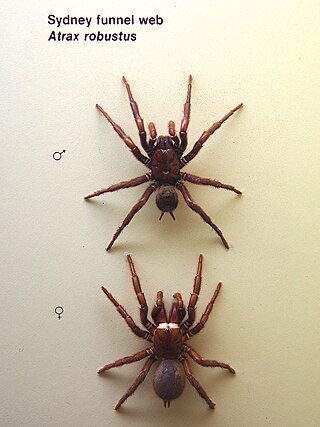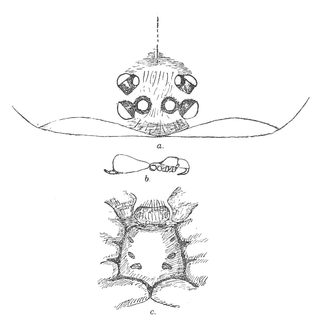
The Sydney funnel-web spider is a species of venomous mygalomorph spider native to eastern Australia, usually found within a 100 km (62 mi) radius of Sydney. It is a member of a group of spiders known as Australian funnel-web spiders. Its bite is capable of causing serious illness or death in humans if left untreated.

The giant burrowing cockroach is also known as the rhinoceros cockroach, and Queensland giant cockroach. These cockroaches are native to Australia and mostly found in tropical and subtropical parts of Queensland. They are the world's heaviest species of cockroach and can weigh up to 30-35 grams and measure up to 7.5-8 cm (3.1 in) in length. It is a member of the family Blaberidae, which contains hundreds of species. It is part of the blaberid subfamily Geoscapheinae. It is prominent in the wild and can also be sold and kept as a pet.

Missulena is a genus of mygalomorph spiders in the family Actinopodidae. It was first described by Charles Walckenaer in 1805, and is a senior synonym of Eriodon. M. tussulena is found in Chile, but the rest are indigenous to Australia. They are sometimes referred to as "mouse spiders" from the now-disproven belief that they dig deep burrows similar to those of mice. Scotophaeus blackwalli is also called a "mouse spider", but it is smaller and not closely related.

Selenocosmia crassipes, synonym Phlogius crassipes, also known as the "Queensland whistling tarantula", "barking spider" or "bird-eating tarantula" is a species of tarantula native to the east coast of Queensland, Australia. The name "whistling tarantula" comes from its ability to produce a hissing noise when provoked, a trait it shares with other Australian theraphosids. This hissing is produced by the spider stridulating a patch of setae associated with its chelicerae. It has also been called the "eastern tarantula". The species name crassipes is Latin for "fat leg" referring to the relatively fat front legs.

Brachychiton rupestris, commonly known as the narrow-leaved bottle tree or Queensland bottle tree, is a tree in the family Malvaceae native to Queensland, Australia. Described by Sir Thomas Mitchell and John Lindley in 1848, it gained its name from its bulbous trunk, which can be up to 3.5 metres (11 ft) diameter at breast height (DBH). Reaching 10–25 metres (33–82 ft) high, the Queensland bottle tree is deciduous, losing its leaves between September and December. The leaves are simple or divided, with one or more narrow leaf blades up to 11 centimetres (4 in) long and 2 centimetres (0.8 in) wide. Cream-coloured flowers appear from September to November, and are followed by woody boat-shaped follicles that ripen from November to May. No subspecies are recognised.

Stanwellia grisea, also known as the Melbourne trapdoor spider, is a species of mygalomorph spider in the Pycnothelidae family. It is endemic to Australia. It was described in 1901 by British arachnologist Henry Roughton Hogg.

The Brigalow Belt is a wide band of acacia-wooded grassland that runs between tropical rainforest of the coast and the semi-arid interior of Queensland and northern New South Wales, Australia. The Interim Biogeographic Regionalisation for Australia (IBRA) divides the Brigalow Belt into two IBRA regions, or bioregions, Brigalow Belt North (BBN) and Brigalow Belt South (BBS). The North and South Brigalow Belt are two of the 85 bioregions across Australia and the 15 bioregions in Queensland. Together they form most of the Brigalow tropical savanna ecoregion.
Euoplos is a genus of armoured trapdoor spiders that is endemic to Australia. It was first described by William Joseph Rainbow in 1914.

Cantuaria dendyi is a species of trapdoor spider in the family Idiopidae. It can be found in the South Island of New Zealand and is limited to the Christchurch and Banks Peninsula area.
Euoplos spinnipes is a species of armoured trapdoor spider in the family Idiopidae. It is found in Queensland, Australia.
Cataxia maculata is a species of mygalomorph spider in the Idiopidae family. It is endemic to Australia. It was described in 1914 by Australian arachnologist William Joseph Rainbow.
Euoplos crenatus is a species of mygalomorph spider in the Idiopidae family. It is endemic to Australia. It was described in 2019 by Australian arachnologists Jeremy Wilson, Michael Rix and Robert Raven.
Euoplos goomboorian is a species of mygalomorph spider in the Idiopidae family. It is endemic to Australia. It was described in 2019 by Australian arachnologists Jeremy Wilson, Michael Rix and Robert Raven. The specific epithet refers to the type locality.
Euoplos thynnearum is a species of mygalomorph spider in the Idiopidae family. It is endemic to Australia. It was described in 2019 by Australian arachnologists Jeremy Wilson, Michael Rix and Robert Raven.
Euoplos turrificus is a species of mygalomorph spider in the Idiopidae family. It is endemic to Australia. It was described in 2019 by Australian arachnologists Jeremy Wilson, Michael Rix and Robert Raven.
Euoplos grandis, also known as the Toowoomba trapdoor spider, is a species of mygalomorph spider in the Idiopidae family. It is endemic to Australia. It was described in 2019 by Australian arachnologists Jeremy Wilson, and Michael Rix.
Euoplos regalis, also known as the regal trapdoor spider or the regal golden trapdoor spider, is a species of mygalomorph spider in the Idiopidae family. It is endemic to Australia. It was described in 2021 by Australian arachnologists Jeremy Wilson and Michael Rix.
Euoplos ornatus is a species of mygalomorph spider in the Idiopidae family. It is endemic to Australia. It was described in 1918 by Australian arachnologists William Joseph Rainbow and Robert Henry Pulleine.
Euoplos similaris, also known as the banded golden trapdoor spider, is a species of mygalomorph spider in the Idiopidae family. It is endemic to Australia. It was described in 1918 by Australian arachnologists William Joseph Rainbow and Robert Henry Pulleine.
Euoplos variabilis, also known as the Mount Tamborine trapdoor spider, is a species of mygalomorph spider in the Idiopidae family. It is endemic to Australia. It was described in 1918 by Australian arachnologists William Joseph Rainbow and Robert Henry Pulleine.







